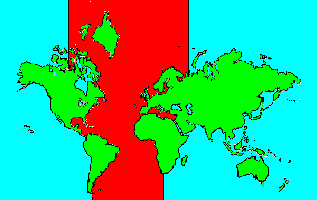SPECIES INFO
Zygorhiza species lived in the Atlantic Ocean probably about 38 million years ago. This 20 foot marine mammal had horizontal lobes on the end of its body. The front legs were changed into fins. It is speculated that this marine species might have bred and birthed on land.The primitive whales-dolphins were first present in the early Eocene era about 60 million years ago. They evolved until about 40 million years ago, and then became extinct. Speculation suggests that these evolved from something related to cattle, horses, or even meat eating mammals. There are over 140 genera in this group known from fossils.
Whales and Dolphins (Order Cetacea) are a group of mammals that are especially modified for swimming. Their rear legs are undeveloped. Their modified front legs and a streamlined body which tapers into a tail facilitate swimming.
There are two main groups in this order. The fish-eating and the plankton-eating groups. The total number of these marine mammals is about eight-two species. The fish-eating groups contain such animals as the Dolphins and Killer Whales. The plankton-eating groups contain the giant whales that filter the plankton from the sea. All members of this order have horizontal tails. (One scientist notes relationships with the hippopotamus.)
Many authors now separate the two groups of whales and dolphins in order to place the meat-eating dolphins nearer the carnivores. However, others argue that both groups share a common land ancestor in the suborder Archaeoceti.
Some representative whale sizes:
Blue Whale (Baleen)- 100 feet
Finback Whale (Baleen)- 80 feet
Bowhead Whale(Baleen)- 60 feet
Sperm Whale (Sperm)- 60 feet
North Atlantic Right Whale(Baleen)- 60 feet
Rorqual (Baleen)- 60 feet
Humback (Baleen)- 50 feet
Pacific Gray Whale (Baleen)- 45 feet
Bairds Whale (Beaked)- 40 feet
Piked Whale (Baleen)- 33 feet
Bottle-nosed Whale (Beaked)- 30 feet
Killer Whale (Dolphin)- 30 feet
Pigmy Right Whale(Baleen)- 20 feet
Mammals (Class Mammalia), together with the birds, are among the youngest of the classes of animals. In species count, mammals number about fifty-one hundred, trailing reptiles (approximately fifty-five hundred), fish (approximately eighteen thousand), and birds (approximately eighty-six hundred).
There are three sub-types of mammals:
monotremes, the most primitive:
Develop in reptilian-like eggs and suckle milk emerging
(i.e., spiny anteater, duckbilled platypus)
marsupials
Newborn emerges very underdeveloped and continue to
mature in a pouch on its mother's abdomen (i.e., opossums,
koala, kangaroo)
placental
Embryo develops within the uterus of the female and is
dependent on a placenta for nutrition and waste removal
(i.e., humans, lions, monkeys)
About sixty-five million years ago, the Tertiary era produced thirty-five orders of mammals. Of this number, eighteen have survived to represent Earth's most diversified as well as its most highly developed classification of animals.
Extinction of mammals is fast becoming a serious issue. Duff and Lawson present a list of forty-one extinct species that reached extinction prior to 1800. These forty-one species are not acknowledged in the counts of the various families. Duff and Lawson also present a list of forty-six species including three gazelles, one zebra, one seal, one deer, and one wolf that have probably gone extinct since 1800. These forty-six species are included in the family counts. Science is adding about forty to fifty new species a year to the list. Many of these are the result of divisions of prior species; some are recent discoveries.
Mammals owe their survival to adaptive capabilities that include the ability to exploit whatever sources of food are available to them, as well as their ability to adjust to various climes. Food specialization influenced evolution to such a great extent that the teeth structure can and has been used to provide extensive information on the food needs and various lifestyles of extinct species.
Despite the vast diversity among mammals in terms of size, habitats and adaptations, they share without exception many characteristics such as:
a. body hair
b. mammary glands
c. certain skull characteristics
d. four limbs that permit speed
e. parallel not perpendicular limbs
f. compartmentalized internal organs
g. a four-chambered heart and pulmonary circulation
Backboned Animals (Phylum Chordata) are the most advanced group of animals on earth. These animals are characterized by having a spinal cord or backbone. Most members have a clearly defined brain that controls the organism through a spinal cord. Fish, amphibians, reptiles, birds, and mammals are in this phylum.
Currently, some taxonomists believe that the fish should be divided into two groups (sharks and regular fishes) and that there are some other primitive groups in the phylum such as hagfish or lampreys.
Animal Kingdom contains numerous organisms that feed on other animals or plants. Included in the animal kingdom are the lower marine invertebrates such as sponges and corals, the jointed legged animals such as insects and spiders, and the backboned animals such as fish, amphibians, reptiles, birds, and mammals.

